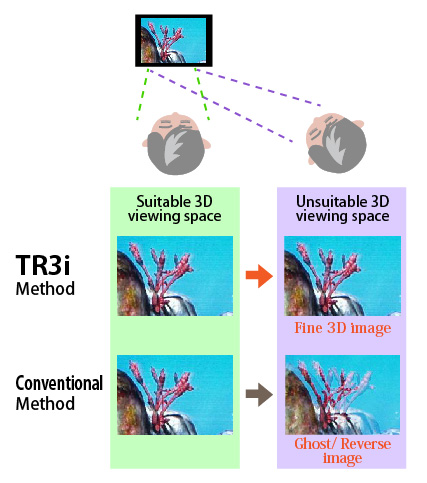NLT Technologies Develops New Unique 3D Eye-Tracking System "TR3i"
- Allows smooth and realistic autostereoscopic display
For immediate use September 27, 2013
NLT Technologies, Ltd.
KAWASAKI, JAPAN, September 27, 2013--- NLT Technologies (NLT) today announced the successful development of a new 3D eye-tracking system which optimizes the autostereoscopic image data corresponding to the eye position of the observer.
This 3D eye-tracking system achieves smooth and realistic 3D images, without the use of glasses, by combining our newly developed 3D image processing engine called “Truly Realistic 3D Imaging” (TR3i), NLT’s proprietary high density autostereoscopic display method called “Horizontally x times Density Pixels” (HxDP), and an eye-tracking device which detects the observer’s eye position with high level of accuracy.
Our newly developed TR3i converts stereo images, optimized for the characteristics of the autostereoscopic display, corresponding to the observer’s eye position which is detected by the eye-tracking device. Usually when an observer moves from a suitable viewing space for 3D images to an unsuitable viewing space, a ghost image occurs, or a reverse image, which is a phenomenon where the observer perceives mixed data or inverted data for the right-eye and left-eye. With TR3i, however, it is possible to provide comfortable 3D images without these problems.
Meanwhile, HxDP, NLT’s proprietary technology is a unique autostereoscopic display technology that achieves high density 3D images by using a unique pixel alignment.(*1)
The combination of our new TR3i 3D image processing engine with our high density HxDP technology makes it possible to achieve more natural and seamless autostereoscopic images by minimizing the influence of a change in observer viewing point.
Recently, the demand for autostereoscopic display has been growing not only for use in consumer games, smart phones, and televisions, but also in industrial applications such as medical and educational equipment. This is attributed to the increasing opportunity of using high quality autostereoscopic images which create a sense of depth, caused by widespread use of stereo camera including endoscopic instruments. At the same time, the industrial market has recognized the value of 3D technology for some of their applications. However, there are still some issues that limit the value of 3D Technology such as ghost images and image reversal, or limitation of suitable 3D viewing space. To address these issues, increasing the number of viewing points on a multi-view autostereoscopic display will broaden the suitable viewing space and reduce image reversal. But increasing the number of viewing points also decreases the density of 3D image. So it is difficult to both minimize image reversal and achieving a high density 3D image.
Our newly developed system offers high quality autosotereoscopic display systems for industrial equipment by dramatically broadening the 3D viewing by using a combination of NLT’s high density HxDP display and their new TR3i eye-tracking device.
NLT is expecting various potential not only to further expand 3D market but also to open up new 3D applications by applying this new technology. By combining NLT’s proprietary TR3i and HxDP technologies and incorporating them into 3D displays, NLT believes that new 3D applications will be developed thus expanding the market for 3D displays. The company will continue to strengthen its product lineup by effectively utilizing its cutting-edge technologies to expand application of LCD modules into new fields and markets.
The prototype equipped the new 3D eye-tracking system will be showcased in NLT Technologies’ booth # 2B01 at CEATEC JAPAN 2013, which is being held from October 1 to 5 in Makuhari Messe, Japan.

*1 More detail for HxDP can be found in the past press release.
"NLT Technologies Introduces High-Resolution Multi-View 2D/3D Display with HxDP Technology for Enhanced Stereoscopic Viewing Experience" (May 14,2012)
The press release and other information in this file may be out of date on observation.


